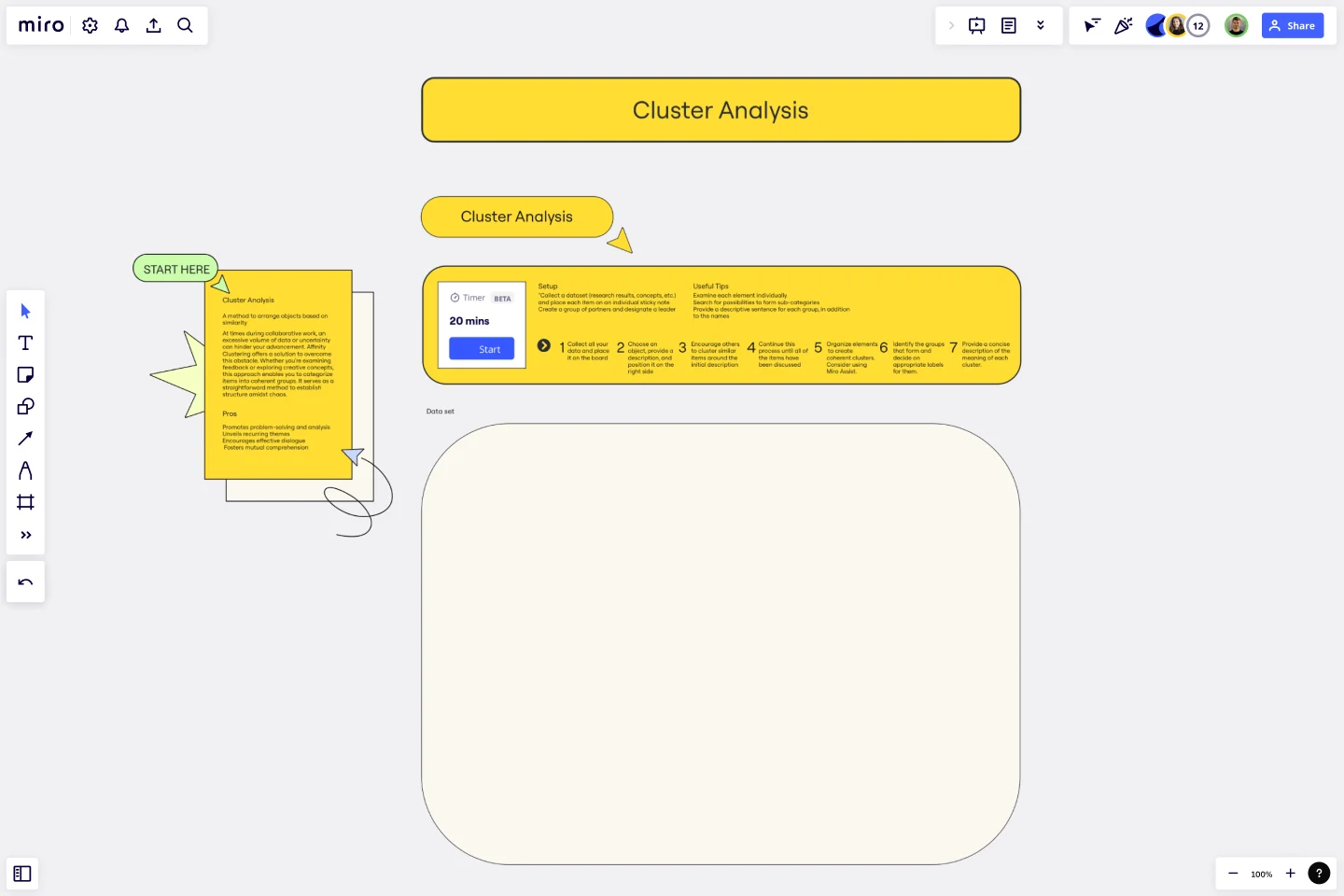Cluster Analysis Template
Arrange objects based on similarity with the Cluster Analysis Template.
About the Cluster Analysis Template
Collaborative work can be challenging, especially when dealing with a large volume of data or uncertainty. In such situations, affinity clustering can be a valuable tool to help you overcome these obstacles. This approach involves grouping items into coherent categories based on their similarities, which can help you make sense of complex information and establish structure amidst chaos.
Whether you're analyzing customer feedback or brainstorming creative concepts, affinity clustering can help you identify patterns and relationships that might not be immediately apparent. By grouping related items together, you can better understand the data and make more informed decisions.
Benefits of using the Cluster Analysis Template
Promote problem-solving and analysis.
Unveil recurring themes.
Encourage effective dialogue.
Foster mutual comprehension.
How to use the template
Collect all your data and place it on the board.
Choose an object, provide a description, and position it on the right side.
Encourage others to cluster similar items around the initial description.
Continue this process until all of the items have been discussed.
Organize elements to create coherent clusters. Consider using Miro AI.
Identify the groups that form and decide on appropriate labels for them.
Provide a concise description of the meaning of each cluster.
Setup
Collect a dataset (research results, concepts, etc.) and place each item on an individual sticky note.
Create a group of partners and designate a leader.
Useful tips
Examine each element individually.
Search for possibilities to form sub-categories.
Provide a descriptive sentence for each group, in addition to the names.
Get started with this template right now.
Proto Persona Template
Works best for:
UX, UX Research, Product Design
The Proto Persona Template is tailored to capture the essence of hypothetical user segments. It encapsulates key attributes such as user needs, behaviors, and potential pain points. One of its standout benefits is its ability to foster empathy. By visualizing and understanding these preliminary user profiles, design and strategy teams can tap into a deeper connection with their target audience, ensuring that solutions resonate authentically and address genuine needs.
Infographic Template
Works best for:
Marketing, Desk Research, Documentation
As we bet you’ve experienced, data can get pretty dense and dry. But you need it to be compelling, memorable, and understandable. The solution? Infographics. These are tools that let you present information in a visually striking way and turn quantitative or qualitative data into stories that engage and resonate. Whoever you’ll be presenting to — customers, donors, or your own internal teams — our template will let you design an infographic that combines text and visuals to break down even the most complicated data.
Heuristic Evaluation Template
Works best for:
Design
The Heuristic Evaluation Template is a valuable tool in UX design. It relies on heuristics to identify usability issues and opportunities for improvement. Similarly, design heuristics serve as guidelines to evaluate the quality of a design solution. Following ten principles of good design can enhance the effectiveness of a product or service. Use these guidelines to evaluate your work and enhance the user experience of your design solutions.
Empathy Mapping With AI Assistance
Works best for:
Research & Design, Market Research
Empathy Mapping AI Assistance template combines traditional empathy mapping with AI insights. This innovative approach helps you understand user needs by integrating data-driven insights with human empathy. Use this template to enhance your product development process and create more personalized user experiences.
Remote Design Sprint Template
Works best for:
Design, Desk Research, Sprint Planning
A design sprint is an intensive process of designing, iterating, and testing a prototype over a 4 or 5 day period. Design sprints are conducted to break out of stal, work processes, find a fresh perspective, identify problems in a unique way, and rapidly develop solutions. Developed by Google, design sprints were created to enable teams to align on a specific problem, generate multiple solutions, create and test prototypes, and get feedback from users in a short period of time. This template was originally created by JustMad, a business-driven design consultancy, and has been leveraged by distributed teams worldwide.
Look Mock Analyze Template
Works best for:
Design, Desk Research, Product Management
Doing your homework (aka, the research) is a key step in your design process, and the Look, Mock, Analyze approach helps you examine, structure, and streamline that step. With this powerful tool you’ll be able to identify your strengths and weaknesses, what you did right or wrong, and whether you spent time efficiently. Our Look, Mock, Analyze template makes it so easy for you to discover inspiration, mock up designs, and get feedback — you can start by setting up your board in less than a minute.
